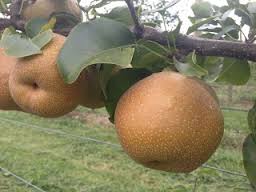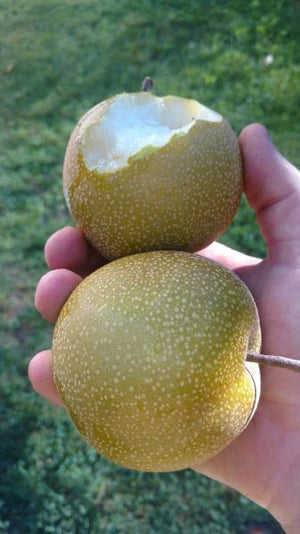MISHIRASU asian pear LARGE SEMI-DWARF (OHxF97)
Shipping calculated at checkout
25 in stock
Need more? Contact us
This tree needs pollination
Compatible trees:
SHINKO asian pear
SHINKO asian pear
SHINSEIKI asian pear tree SEMI-DWARF (OHxF87)
SHINSEIKI asian pear tree SEMI-DWARF (OHxF87)
CHOJURO asian pear DWARF (OHxF87)
CHOJURO asian pear DWARF (OHxF87)
Available only in spring 2026
🍐 Asian pear ‘Mishirasu’
🔎 Description
The Asian pear ‘Mishirasu’ (Pyrus pyrifolia ‘Mishirasu’) is a Japanese variety notable for the exceptional size of its fruit, which can exceed 450 g each. Selected on the island of Hokkaido, this cultivar produces crisp, juicy, and sweet pears with russet-brown skin. Ideal for fresh consumption, it is also notable for its good storage capacity.
🌳 Main characteristics
- Botanical name
- Pyrus pyrifolia ‘Mishirasu’
- Pyrus pyrifolia ‘Mishirasu’
- Origin
- Japan (selected by Dr. Hoshino, around 1887)
- Japan (selected by Dr. Hoshino, around 1887)
- Habit
- Vigorous, rounded tree
- Vigorous, rounded tree
- Foliage
- Deciduous, dark green, turning orange in fall
- Deciduous, dark green, turning orange in fall
- Flowering
- April-May, fragrant white flowers
- April-May, fragrant white flowers
- Pollination
- Requires a compatible pollinator (another Asian or European pear tree)
- Requires a compatible pollinator (another Asian or European pear tree)
- Hardiness
- Down to -25°C (USDA zone 5)
- Down to -25°C (USDA zone 5)
- Mature height
- 3 to 4 m
- 3 to 4 m
- Mature width
- 3 to 4 m
- 3 to 4 m
🍐 The fruit
- Size: very large (350 to 500 g)
- Shape: rounded, slightly flattened
- Skin: brown to coppery, often russeted
- Flesh: white, firm, crisp, and very juicy
- Taste: mild, sweet, refreshing
- Harvest: late September to early October
- Storage: excellent (several weeks in a cellar or cold room)
🌞 Cultivation and care
- Exposure: full sun
- Soil: rich, loose, well-drained, slightly acidic to neutral
- Planting: fall or spring (frost-free)
- Watering: regular in the first few years; then tolerates slight drought
- Pruning: at the end of winter – thin out the center, remove dead wood and crossing branches
- Mulching: recommended to retain moisture and protect the roots from the cold
⚠️ Points to note
- Provide a pollinator with a similar flowering period (e.g., ‘Shinseiki’, ‘Chojuro’, ‘Hosui’).
- The fruit, although delicious, often has a very russeted skin (more rustic than commercial appearance).
- Avoid heavy or poorly drained soils (risk of root rot).
💡 Advantages
✅ Giant, tasty fruit
✅ Regular, abundant production
✅ Rustic, decorative tree
✅ Fruit keeps well
✅ Suitable for northern climates (up to zone 5)
📍 Advice for cold climates (Quebec/Mauricie)
In zones 4b-5, choose a south-facing location that is well sheltered from the wind.
Protect the young tree for the first two winters with a thick layer of mulch (6 inches) and, if possible, a windbreak.
The ‘Mishirasu’ variety performs well when grafted onto a hardy rootstock such as OHxF 97.
🌿 Uses
- Family orchard or ornamental garden
- Fresh consumption or in fruit salads
- Long-term storage or processing (juice, jams, desserts)
Hardiness Zones
Number of years for production
2 years
Light
Uses / Special remarks





